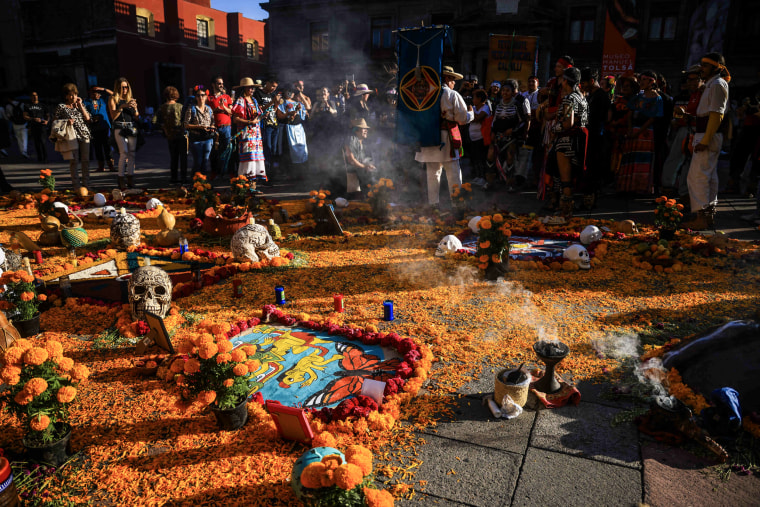LOS ANGELES — Día de los Muertos, or Day of the Dead, is a time for family and friends to remember their late loved ones and according to tradition, reunite with them.
The two-day celebration, which takes place annually on Nov. 1 and Nov. 2, is not a somber holiday. Instead, it celebrates and honors the dead with festivities filled with color, music and food.
Originating and widely observed in Mexico, the holiday has since expanded into Latin America and the United States, including Los Angeles, where the Hollywood Forever Cemetery holds an annual Día y Noche de los Muertos event.
“It’s a celebration about honoring and keeping alive the memory of your loved ones and believing that one day you’ll be together. (It is believed) on that one day, even though you’re alive, that realm opens up and you’re together on the Day of the Dead,” Deisy Marquez, Día y Noche de los Muertos event founder, said to TODAY.com ahead of their Oct. 28 event in Los Angeles. “The celebration, and the event itself, it’s very deep and meaningful for a lot of people and everybody has a different idea (of how to celebrate).”
Whether it’s gathering at home or the cemetery, building ofrendas or altars with photos of deceased loved ones and marigolds, dressing up and sharing loved ones’ favorite foods, there are many ways to celebrate Día de los Muertos.
El Día de los Muertos’ history
Día de los Muertos originated in Mexico, with the celebrations combining Aztec rituals with Catholicism brought to the region by Spanish colonization, as National Geographic reports. It then became a mix of the Aztec festival in honor of goddess Mictecacihuatl, the “Lady of the Dead” who watches over the bones of the dead. The Aztecs would help the deceased on their journey to the afterlife, offering useful objects to guide them and placing them on their burial sites. This would later be known as ofrendas, or offerings, that are placed on the altars or shrines dedicated to the dearly departed.
In some places, it begins on Oct. 31, Halloween, and concludes on Nov. 2, also known as All Souls’ Day. Nov. 1 honors deceased children and Nov. 2 focuses on adults.
In some regions, as the History Channel reports, it’s believed the gates of heaven are opened at midnight on Halloween and the spirits of children can rejoin their families for 24 hours on Nov. 1. The spirits of adults can do the same on Nov. 2. However, there are contradicting stories of how the spirits of the children come on Nov. 1, which showcases how different regions celebrate the holiday differently.
To prepare for the spirits’ arrival, people make ofrendas or altars that include photos of the deceased, sugar skulls — which represent death and rebirth — as well as favorite foods and belongings of the deceased.
The altars also include the flor de Cempasuchil, or marigold, an orange flower that grows around Mexico in the fall. It is included in the ofrendas not only because they are seen everywhere during that time, but because according to Mexican folklore, its strong smell is believed to attract spirits.
How it’s celebrated today
In Mexico, states and regions celebrate it differently. In Hollywood Forever Cemetery in California, they make it a priority to showcase those differences by holding a unique theme each year.
For the past 24 years, Hollywood Forever president Tyler Cassity and Marquez, along with their team, visit a specific state in Mexico and learn about the community’s Day of the Dead customs and rituals.
This year for their Oct. 28 event the theme was “Máscaras de México — Vida y Muerte en La Máscara,” which explored the significance of masks in Mexican and Latin American culture during the Day of the Dead and was inspired by the late Mexican painter Rafael Coronel, who was chosen as the artist of the year.
“The significance of the mask is that it’s a transformative part of a ritual. As you are dying, moving on to the next life, you’re putting on a mask so that you can still see yourself as you were,” Gabriel Avila, director of dance and theme at Hollywood Forever, said.
“It’s also an idealized version of who you want to continue to be,” Avila said. “And even though you’ve transpired to another realm, whatever the beauty in the mask is, it still represents who you are and it carries that idea of the soul continuing to live forever.”
The event is near and dear to many. It’s also a big family celebration with costume and altar contests, live music and food vendors celebrating Mexican culture at the cemetery.
Cassity noted that their celebration is not just for people of Mexican heritage but for all Angelenos and those who want to pay tribute to their loved ones. Marquez said that it’s a way for immigrants and people who can’t go back to Mexico or their native land to honor their culture, family and friends.
“We have people from all around the world that know about it,” Marquez said. “We try to give some insight into Mexican culture but at the same time it is embraced by so many different countries.”
A special ritual at home or at the cemetery
Aside from celebrations in towns and cities, families make intimate at-home altars or decorate their loved one’s burial site and hold a picnic or celebration. Others will attend special Catholic masses and have a mariachi.
Author Annette Chavez Macias said she didn’t celebrate Día de los Muertos growing up, but recently started setting up an ofrenda at her home and a mini one at her office.

“My dad is from Mexico and my mom is second-generation Mexican American,” she said. “Several years ago, I started hearing about it and seeing more of the celebrations on social media and online. By then I had lost some relatives and the symbolism of remembering our loved ones during this time really affected me.”
Macias sees Día de los Muertos “as a beautiful way to honor their memory” and a way to educate herself on the tradition. As more of her family members join in, they begin setting up their ofrendas in mid-October, adding more until the altar is completed by Oct. 28. They also decorate her dad and grandparents’ graves and try to attend Day of the Dead events in her area.
For Rene Flores Juarez, 68, who hails from Atlixco, Mexico and currently lives in Brooklyn, New York, the Day of the Dead is a multi-day celebration starting Oct. 28. As he told TODAY.com in Spanish, on the first day they place a white candle, white flower and a glass of water on the altar for the souls who don’t have any family.
As the days continue and they are “esperando a nuestros muertitos” (waiting for our deceased), they light another candle, place a glass of water and white bread, fruit and marigolds, among other tokens. By Nov. 1, or All Saints’ Day, he said all the “angelitos” (little angels) come, “the souls of the children who died,” he explained.
On Nov. 1 they put all the food on the altar, Flores Juarez said, because Nov. 2 is when the adult souls return and more personal belongings are placed on the altar. By Nov. 3, they begin to say goodbye to their dearly departed. “That’s why the fruit spoils and it doesn’t taste the same… It means they have eaten it and have taken it with them,” he said in Spanish.
Los Angeles native Brandie Carlos said that growing up in East Los Angeles, she lived two blocks from an art center, Self Help Graphics, where nuns started celebrating the holiday. Her family, who is from Sahuayo, Michoacán, Mexico, began making their own altars at home after being inspired by the local celebration.
“Since I was little, I remember putting together the altar with photos of our loved ones and their favorite foods and drinks like rice and beans, birrote (bread), Mexican candy and liquor,” Carlos said. “We always went to downtown Los Angeles to the flower market to buy fresh marigolds for the altar. We would also make it a point to eat their favorite meals during this time.”
For Carlos, because the tradition has become a special part of her family, they have the altar up year-round.
“But we do decorate it more starting mid-to-late-October. We had a death in the family in July, our matriarch, my Nina Marina, and I know it’s going to be extra emotional because she was the one who taught us to create the altar,” she said. “And now she’ll be on it for the first time.”
A version of this story was first published on Today.com.
Source: | This article originally belongs to Nbcnews.com










